
Commersonia dasyphylla, commonly known as kerrawang, is a species of flowering plant of the family Malvaceae and is endemic to eastern continental Australia. It is a shrub with egg-shaped to lance-shaped with irregular edges and flowers in groups of up to 21, followed by hairy brown capsules.
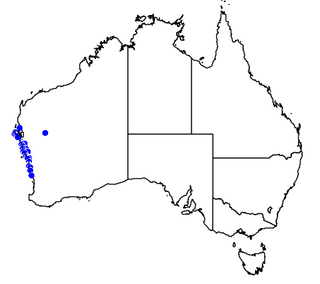
Commersonia borealis is a species of flowering plant in the family Malvaceae and is endemic to the southwest of Western Australia. It is a low growing, spreading shrub with egg-shaped to oblong leaves, and white, yellow and cream-coloured flowers.

Androcalva rosea, commonly known as Sandy Hollow commersonia, is a small endangered shrub with pink flowers and prostrate trailing branches. It is only known from four locations in the Hunter Valley of New South Wales.
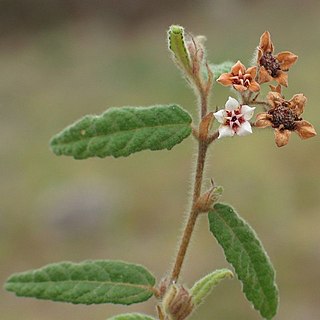
Commersonia breviseta is a species of flowering plant in the family Malvaceae and endemic to eastern Australia. It is a dwarf shrub with densely-hairy, egg-shaped to narrow elliptic leaves that are paler on the lower surface, and flowers with five white sepals with pink edges, five smaller pale yellow petals and dark red stamens.
Commersonia corylifolia, commonly known as hazel-leaved rulingia, is a species of flowering plant in the family Malvaceae and endemic to the southwest of Western Australia. It is a spreading, erect shrub with egg-shaped to narrowly egg-shaped leaves, and white to cream-coloured flowers.
Commersonia grandiflora is a species of flowering plant in the family Malvaceae and is endemic to the south of Western Australia. It is an erect, open shrub with hairy, egg-shaped to elliptic leaves, and white or cream-coloured flowers.
Commersonia parviflora, commonly known as small flowered rulingia, is a species of flowering plant in the family Malvaceae and is endemic to the south of Western Australia. It is a low, prostrate or dense shrub with wrinkled, egg-shaped leaves with rounded teeth on the edges, and clusters of small, white flowers.

Commersonia prostrata, commonly known as dwarf kerrawang, is a species of flowering plant in the family Malvaceae and endemic to eastern continental Australia. It is a prostrate shrub with trailing branches, egg-shaped leaves, the lower surface densely covered with star-like hairs, white, petal-like sepals, and smaller, pinkish petals.
Commersonia rotundifolia, commonly known as round-leaved rulingia, is a species of flowering plant in the family Malvaceae and endemic to the south-west of Western Australia. It is an upright, openly-branched shrub with elliptic to round leaves with wavy edges, and white flowers in clusters of 3 to 10.
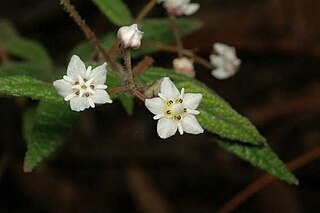
Commersonia rugosa is a species of flowering plant in the family Malvaceae and endemic to New South Wales. It is an open, straggly shrub with linear to narrowly egg-shaped leaves with irregular teeth or lobes on the edges, and white flowers in clusters of 3 to 15.
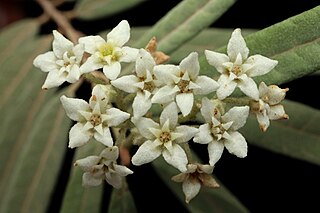
Commersonia salviifolia is a species of flowering plant in the family Malvaceae and endemic to eastern Australia. It is a shrub with lance-shaped leaves and white flowers in clusters of 5 to 30.
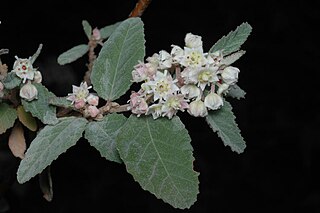
Commersonia erythrogyna, commonly known as Trigwell's rulingia, is a species of flowering plant in the family Malvaceae and is endemic to a restricted part of the south-west of Western Australia. It is an open, straggly shrub with oblong to egg-shaped leaves and creamy-white flowers.
Commersonia gilva, commonly known as golden commersonia, is a species of flowering plant in the family Malvaceae and is endemic to the south-west of Western Australia. It is an erect shrub with elliptic to oblong or egg-shaped leaves and yellow flowers.
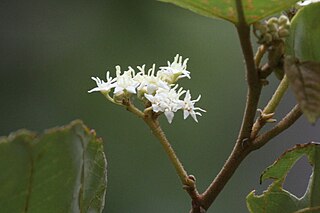
Commersonia macrostipulata is a species of flowering plant in the family Malvaceae and is endemic to Queensland. It is a shrub or tree with egg-shaped leaves that are slightly serrated on the edges, flowers with five cream-coloured to white sepals and bristly fruit.
Androcalva beeronensis is a species of flowering plant in the family Malvaceae and is endemic to Queensland. It is a shrub that forms suckers from rhizomes and has branchlets and leaves covered with soft, golden hairs, the leaves egg-shaped to lance-shaped with toothed edges, and clusters of 9 to 24 cream-coloured to white flowers.
Androcalva inglewoodensis is a species of flowering plant in the family Malvaceae and is endemic to south-eastern Queensland. It is a spreading, prostrate shrub that has hairy young branchlets, egg-shaped to elliptic leaves with irregularly serrated edges, and small groups of white to cream-coloured flowers.

Androcalva melanopetala is a species of flowering plant in the family Malvaceae and is endemic to southern inland Western Australia. It is a sometimes prostrate shrub that has densely hairy new growth, egg-shaped to elliptic leaves with rounded teeth on the edges, and clusters of white or cream-coloured and pink to red flowers.

Androcalva multiloba is a species of flowering plant in the family Malvaceae and is endemic to the Eyre Peninsula of South Australia. It is a dwarf shrub with densely hairy, irregularly serrated, egg-shaped leaves, and up to 5 white and red flowers arranged opposite leaf axils or on the ends of branches.
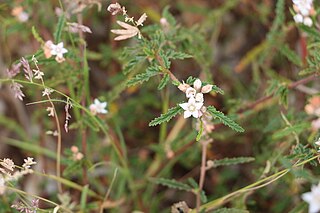
Androcalva pedleyi is a species of flowering plant in the family Malvaceae and is endemic to south-eastern Queensland. It is low, spreading or prostrate shrub that forms suckers and has softly-hairy new growth, linear to lance-shaped leaves with lobes on the edges, and groups of 7 to 10 white, later pink flowers.
Androcalva perkinsiana, commonly known as headland commersonia, is a species of flowering plant in the family Malvaceae and is endemic to a restricted part of central eastern Queensland. It is a small, erect shrub with hairy young branchlets, oblong or lance-shaped leaves with 5 to 11 pairs of small serrations on the edges, and groups of 3 to 4 pale purple flowers.













